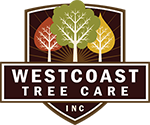April showers bring May flowers. Spring can also bring with it disease and unwanted insects that affect the health and integrity of your beautiful trees. Therefore it’s crucial to start any tree care efforts early before the trees on your property come out of dormancy. That’s why Westcoast Tree Care would like to provide you with information on what to watch out for and how to take preventative tree care measures.
Fungal Diseases
When it comes to fungal diseases that can affect your trees, blight and anthracnose are fungi that can quickly spread to nearby trees. If the trees on your property have experienced any issues with either of these fungal diseases, it’s important to detect, treat, and protect them before spring growth begins.
Blight
Blight is a fungal disease that can blacken the leaves and stems of your tree. If left untreated, this disease can quickly overrun your landscape, killing your plants and trees.
Anthracnose
When the health of a tree weakens, it is especially susceptible to a group of destructive fungal pathogens known as anthracnose. These harmful fungi tend to attack the main vein of a trees leaves causing discoloration, foliage dieback, and a further decline to a trees overall health.
Before temperatures rise and the trees on your property come out of dormancy, you can stop the spread of harmful, invasive fungi by spraying them with fungicides recommended by a certified arborist.
Fungal Treatment Tips
Following a recommended fungal treatment, it’s also important to treat the same areas with an insecticide to help prevent any insects that tend to attack an unhealthy tree.
Even more, it’s important to prune all of the affected areas of a tree and remove it from your property to prevent the spread of disease. Keep in mind you do not want to add any pruned branches or limbs to any compost containers or mulch piles as this will provide the perfect environment for harmful fungi to grow and spread.
Insect Infestations
Insect infestations are easily managed when the trees on your property are cared for, pruned, and inspected on a regular basis. However, an infestation can still happen. That’s why Westcoast Tree Care would like to provide you with some of the characteristics of one of the most common insect invaders.
Aphids
Aphids can range from different colors of black, green, red, yellow or brown. Pear-shaped in appearance, they can easily be identified compared to other insects by their tube like projections at the rear of their bodies. Many aphid species will also secrete a white or grayish substance giving them a wax-like appearance.
Even more, some aphid species have wings that enable them to fly to other locations in search of susceptible trees and plants to feed on. This trait, along with their destructive nature makes it especially important to get them under control quickly.
Ants can also be found near aphid infestations. While ants don’t’ necessarily harm a tree, they do, however, help care for aphids by cultivating the honeydew that they produce. That’s why it’s important to stop and remove ants from reaching aphids in order to eliminate an unwanted infestation.
In any given region, aphids can affect the health and integrity of trees depending on your specific landscape. That’s why it’s important to consult with a certified arborist about the best treatment options including pruning and other preventative tree care services.
Eugene Tree Care
Early spring is the best time to get up close and personal with the trees on your property. This is when you should have them pruned and inspected for any signs of disease and insect infestations. If you would like more information, contact the certified arborist at Westcoast Tree Care at 1.800.767.8733 today. We would be more than happy to answer any questions you may have about our preventative tree care services and will provide you with a no-cost, no-obligation quote.








